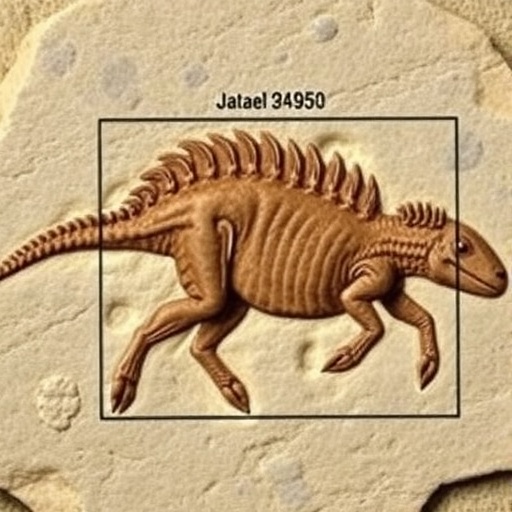Recent paleontological discoveries from Brazil have shed new light on the evolution of proterochampsids, a group of archosauriform reptiles that thrived during the Middle Triassic period. A crucial study led by researcher R.T. Müller reveals new proterochampsid remains, enhancing our understanding of this group’s diversity during its formative years. The findings, published in Sci Nat, could reshape our comprehension of evolutionary pathways in these ancient reptiles and their ecological roles in prehistoric ecosystems.
Müller’s research uncovers fossil specimens that show significant morphological variation among proterochampsids, a previously understudied group of reptiles that have intricate ties to the lineage leading to modern crocodilians and birds. The fossils, unearthed in Brazilian sediments, indicate that the diversity of this group was far more extensive than previously believed, signifying a pivotal chapter in the evolutionary tale of reptiles.
The Middle Triassic period, dating back approximately 247 to 237 million years ago, represents a crucial interval of recovery following the Permian-Triassic extinction event. This epoch witnessed a diversification of life forms, particularly among archosaurs. Müller’s findings suggest that proterochampsids played a vital role in this diversification, occupying ecological niches that other reptiles had not yet explored. Their anatomy, adapted for both terrestrial and semi-aquatic lifestyles, showcases their variability and adaptability in dynamic environments.
The study meticulously documents the fossil remains, utilizing advanced imaging and analysis techniques to uncover features that were not visible to the naked eye. By creating three-dimensional reconstructions of the skulls and limbs, Müller has been able to identify distinctive traits that set these creatures apart from other reptiles of their time. Key features include variations in limb ratios and cranial morphology, which provide insights into their locomotion and feeding habits.
Moreover, Müller emphasizes the importance of the geographical context of these fossils. The Middle Triassic deposits in Brazil are rich with other vertebrate remains and provide a unique window into a paleoenvironment that was diverse and complex. As these sediments are studied further, they may yield additional specimens that could inform researchers about the range of habitats proterochampsids occupied and their interactions with other contemporaneous reptiles and fauna.
From an evolutionary perspective, the findings pose intriguing questions about the adaptive strategies employed by proterochampsids. Their combination of terrestrial mobility and aquatic proficiency suggests they were no ordinary reptiles. This capability may have allowed them to thrive in fluctuating environments, competing effectively with more basal reptiles for food and terrain. Moreover, such adaptability raises questions about the ecological pressures that shaped their evolution.
As Müller presents his findings, he also calls for a reevaluation of proterochampsid phylogeny. The discovery of these new fossils prompts a reconsideration of the branching relationships among Triassic reptiles. The study proposes that the lineage of proterochampsids may be more deeply rooted in the archosaur family tree than previously understood, offering a new perspective on the evolutionary progressions that eventually led to the rise of dinosaurs.
One of the significant implications of this research is its assertion that the narrative of reptile evolution during the Mesozoic era may be more complex than traditionally portrayed. The presence of diverse proterochampsid morphologies suggests that multiple evolutionary experiments were ongoing during this period. It highlights the idea that rather than a linear progression towards modern forms, reptile evolution may have been marked by a branching and adaptive radiation model.
The meticulous approach taken by Müller aligns with recent trends in paleontological research that emphasize the importance of collaborative studies, integrating various scientific disciplines—from sedimentology to computational biology. Such interdisciplinary collaboration can lead to more comprehensive insights into the evolutionary history of ancient life forms and their ecosystems.
In conclusion, Müller’s groundbreaking research expands the known geographical and morphological boundaries of proterochampsids. With the evidence he presents, it becomes clear that the diversity of life during the Middle Triassic was remarkable and intricate, paving the way for a more robust dialogue about the evolution of reptiles. As more fossils are unearthed in Brazil and beyond, the story of proterochampsids signals a compelling chapter in the history of vertebrates.
The future of paleontological research promises more revelations about the interconnectedness of life forms and the complex narratives that emerge from the fossil record. By understanding these ancient creatures, researchers aim not only to illustrate the past but also to extrapolate lessons on resilience and adaptability that may resonate within contemporary discussions on biodiversity and conservation.
In a world facing rapid environmental changes, the saga of proterochampsids serves as a reminder of the evolutionary processes that shape life on Earth, emphasizing the importance of preserving our natural heritage for future generations.
Subject of Research: The diversity and evolutionary significance of proterochampsids in the Middle Triassic of Brazil.
Article Title: New proterochampsid remains from the Middle Triassic of Brazil enhance the group’s diversity during its origins.
Article References:
Müller, R.T. New proterochampsid remains from the Middle Triassic of Brazil enhance the group’s diversity during its origins. Sci Nat 112, 28 (2025). https://doi.org/10.1007/s00114-025-01981-5
Image Credits: AI Generated
DOI: https://doi.org/10.1007/s00114-025-01981-5
Keywords: Proterochampsids, Middle Triassic, Brazil, Paleontology, Archosauriforms, Evolution, Biodiversity




